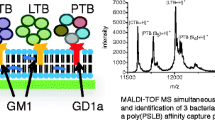Abstract
We report on a novel method for the quantitation of proteins specifically bound on a ligand-presenting biochip by matrix-assisted laser desorption/ionization time-of-flight (MALDI-TOF) mass spectrometry (MS). The bound protein was digested by trypsin, and the resulting peptide fragments were analyzed by MALDI-TOF MS in the presence of an isotope-labeled internal standard (IS). The IS has the same sequence as a reference peptide (RP) of the target protein digest, but a different molecular weight. The absolute amount of the specifically bound protein on a biochip is then quantitated by comparison of mass intensities between the RP and the IS. Because they have the same molecular milieu, the mass intensities of these two analytes represent the real amounts of analytes on the chip. As a model system, we tested glutathione s-transferase (GST) and a GST-fusion protein, which were captured on glutathione-presenting biochips. We observed that the glutathione densities on biochips showed a good correlation with the absolute quantity of the proteins. We believe that our method will provide an alternative to currently existing tools for the absolute quantitation of surface-bound proteins.
Similar content being viewed by others
References
S. Spisak, Z. Tulassay, B. Molnar, and A. Guttman, Electrophoresis, 2007, 28, 4261.
S. Spisak and A. Guttman, Curr. Med. Chem., 2009, 16, 2806.
L. A. Kung and M. Snyder, Nat. Rev. Mol. Cell Biol., 2006, 7, 617.
H. Zhu and M. Snyder, Curr. Opin. Chem. Biol., 2003, 7, 55.
A. Guo and X. Zhu, Int. J. Nanosci., 2007, 6, 109.
Y.-S. Lee and M. Mrksich, Trends Biotechnol., 2002, 20, S14.
R. J. Green, R. A. Frazier, K. M. Shakesheff, M. C. Davies, C. J. Roberts, and S. J. B. Tendler, Biomaterials, 2000, 21, 1823.
B.-K. Oh, W. Lee, B. S. Chun, Y. M. Bae, W. H. Lee, and J.-W. Choi, Biosens. Bioelectron., 2005, 20, 1847.
H. Ogi, H. Naga, Y. Fukunishi, M. Hirao, and M. Nishiyama, Anal. Chem., 2009, 81, 8068.
M. Henry, C. Dupont-Gillain, and P. Bertrand, Langmuir, 2008, 24, 458.
M. I. Jones, I. R. McColl, D. M. Grant, and T. L. J. Parker, Biomed. Mater. Res., 2000, 52, 413.
K. Salchert, T. Pompe, C. Sperling, and C. Werner, J. Chromatogr., A, 2002, 1005, 113.
P. Roach, N. J. Shirtcliffe, D. Farrar, and C. C. Perry, J. Phys. Chem. B, 2006, 110, 20572.
T. Sandberg, L. Mellin, U. Gelius, and K. D. Caldwell, J. Colloid Interface Sci., 2009, 333, 180.
E. Szájli, T. Fehér, and K. F. Medzihradszky, Mol. Cell. Proteomics, 2008, 7, 2410.
S. A. Gerber, J. Rush, O. Stemman, M. W. Kirschner, and S. P. Gygi, Proc. Natl. Acad. Sci. U. S. A., 2003, 100, 6940.
V. Brun, A. Dupuis, A. Adrait, M. Marcellin, D. Thomas, M. Court, F. Vandenesch, and J. Garin, Mol. Cell. Proteomics, 2007, 6, 2139.
J. Lahiri, L. Isaacs, J. Tien, and G. M. Whitesides, Anal. Chem., 1999, 71, 777.
For detailed preparation and characterizations of glutathione-presenting monolayers, see; W.-S. Yeo, D.-H Min, R. W. Hsieh, G. L. Greene, and M. Mrksich, Angew. Chem., Int. Ed., 2005, 44, 5480; J. R. Lee, J. Lee, S. K. Kim, K. P. Kim, H. S. Park, and W.-S. Yeo, Angew. Chem., Int. Ed., 2008, 47, 9518.
E. Caputo, R. Moharram, and B. M. Martin, Anal. Biochem., 2003, 321, 116.
H.-J. Seok, M.-Y Hong, Y.-J. Kim, M.-K. Han, D. Lee, J.-H. Lee, J.-S. Yoo, and H.-S. Kim, Anal. Biochem., 2005, 337, 294.
M. Mrksich and G. M. Whitesides, ACS Symp. Ser., 1997, 680, 361.
Note that the ligand density indicates the ratio of alkanethiols in solution which in general does not strictly match the ratio of alkanethiolates in the monolayer.
The structure is available at PDB (http://www.rcsb.org), access code 1UA5.
D.-H. Tsai, F. W. DelRio, A. M. Keene, K. M. Tyner, R. I. MacCuspie, T. J. Cho, M. R. Zachariah, and V. A. Hackley, Langmuir, 2011, 27, 2464.
Author information
Authors and Affiliations
Corresponding author
Electronic supplementary material
Rights and permissions
About this article
Cite this article
Lee, J., Ryoo, SR., Kim, S.K. et al. Quantitation of Surface-bound Proteins on Biochips Using MALDI-TOF MS. ANAL. SCI. 27, 1127–1131 (2011). https://doi.org/10.2116/analsci.27.1127
Received:
Accepted:
Published:
Issue Date:
DOI: https://doi.org/10.2116/analsci.27.1127




